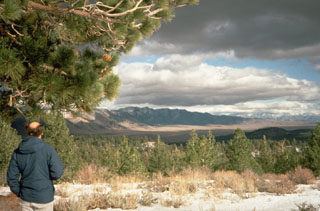Report on Long Valley (United States) — June 1982
Scientific Event Alert Network Bulletin, vol. 7, no. 6 (June 1982)
Managing Editor: Lindsay McClelland.
Long Valley (United States) Minor earthquake swarm; additional uplift of resurgent dome since 1980
Please cite this report as:
Global Volcanism Program, 1982. Report on Long Valley (United States) (McClelland, L., ed.). Scientific Event Alert Network Bulletin, 7:6. Smithsonian Institution. https://doi.org/10.5479/si.GVP.SEAN198206-323822
Long Valley
United States
37.7°N, 118.87°W; summit elev. 3390 m
All times are local (unless otherwise noted)
Since the seismic swarm of 7-8 May, only 1 minor swarm of microearthquakes has been recorded in the epicentral area under the S side of the caldera. This swarm occurred 13 July at 1200 and consisted of six minor shocks of M 1.5 or less during a span of 1.5 hours, at a depth of about 3.5-5.5 km. The swarm was not accompanied by spasmodic tremor. Seismicity otherwise has been at background levels.
Relevelling of U.S. route 395 across the resurgent dome in June 1982 revealed additional uplift since September 1980—a maximum of 8.2 cm at the crest of the dome, suggesting an average rate of uplift of about 0.5 cm/month during the 18-month time span.
Gas analyses and H2 probe work that began in May have shown no systematic changes at Casa Diablo Hot Springs (2.5 km E of the epicentral area), where increased fumarolic activity was discovered in January. The USGS, University of Nevada, California Division of Mines and Geology, and USFS are continuing a coordinated geophysical and geochemical monitoring program at Long Valley.
Geological Summary. The large 17 x 32 km Long Valley caldera east of the central Sierra Nevada Range formed as a result of the voluminous Bishop Tuff eruption about 760,000 years ago. Resurgent doming in the central part of the caldera occurred shortly afterwards, followed by rhyolitic eruptions from the caldera moat and the eruption of rhyodacite from outer ring fracture vents, ending about 50,000 years ago. During early resurgent doming the caldera was filled with a large lake that left strandlines on the caldera walls and the resurgent dome island; the lake eventually drained through the Owens River Gorge. The caldera remains thermally active, with many hot springs and fumaroles, and has had significant deformation, seismicity, and other unrest in recent years. The late-Pleistocene to Holocene Inyo Craters cut the NW topographic rim of the caldera, and along with Mammoth Mountain on the SW topographic rim, are west of the structural caldera and are chemically and tectonically distinct from the Long Valley magmatic system.
Information Contacts: R. Bailey, USGS, Reston, VA; T. Casadevall, D. Dzurisin, USGS CVO, Vancouver, WA; A. Ryall, Univ. of Nevada, Reno; W. Duffield, R. Cockerham, USGS, Menlo Park, CA.

